How to make perfect buttermilk pancakes
Through all the breakfast fads, pancakes stand resolute, the definitive breakfast dish, something almost everyone loves and all of us should master. They are the indulgent heroes of the breakfast table: eggy, salty and just this side of sweet. There may have been struggles with burned bottoms and raw interiors in your past, but with a well-made batter and some practice with your stove, you can achieve pancake perfection.
Before you start
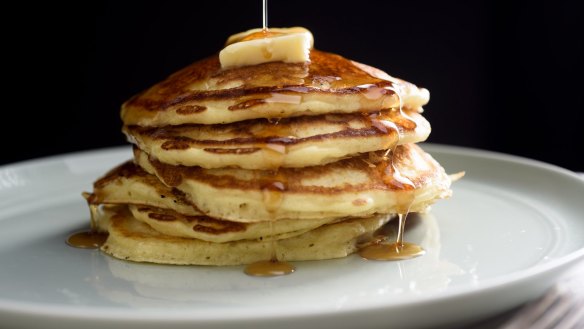
You're probably making pancakes for more than one person. To properly serve them warm all at once, heat your oven to 160 degrees , and store the pancakes there on a wire rack-lined baking tray until all the pancakes are made.
It's helpful to have all your ingredients ready before beginning to cook. This means the dry ingredients are measured out, the buttermilk is poured and the butter is cooled and melted.
A flat grill is the best surface for making pancakes, but if you don't have one, a large, well-seasoned cast-iron frypan is ideal. It will distribute heat evenly and give you a hassle-free, non-stick experience.
You'll need a whisk or fork for mixing and a spatula for flipping. Choose a spatula that is large, wide, angled and heat-proof. Fish spatulas are actually a great tool here, providing the proper width and flexibility needed to flip.
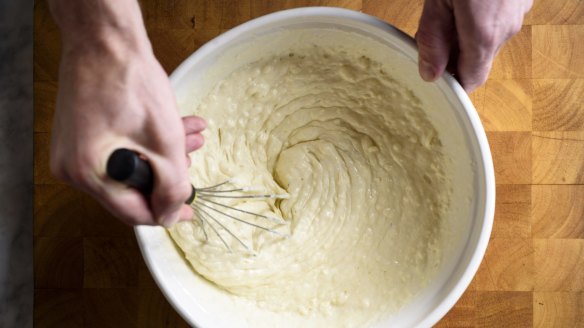
The batter
Great pancakes start with a great batter. A well-seasoned, well-balanced batter, mixed properly (yes, there's a way to do that) makes for a perfect pancake every time. The instructions below are for a classic buttermilk pancake, but we'll take you through flours and mix-ins later on.
The ingredients
The correct ratio of eggs to buttermilk will create a tangy, custard-like interior; there is no true rule of thumb for this, but our master recipe below will give you a good template. Baking powder and baking soda will build the ideal lift and a light texture, and the right amount of sugar will help crisp the edges without crossing into dessert territory. And yes, there is quite a bit of salt. But if you try to cut back, you will miss it. As with any food, pancakes need proper seasoning.
The mixing
Whisk all the dry ingredients together in a large bowl, then create a well in the centre to pour the buttermilk and crack the eggs (no need to combine the eggs with the buttermilk first – there are only so many mixing bowls you should wash this early in the day). Starting from the centre and moving towards the edges, incorporate all the dry ingredients into the wet until no obvious dry bits remain.
Pancake batter should never be overmixed. This develops gluten, which will make a tough pancake. Do not be afraid of a few lumps here. They'll take care of themselves.
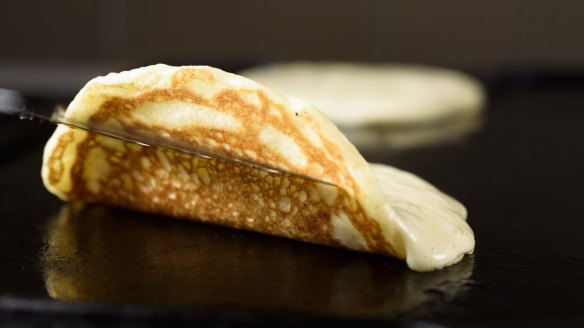
Cooking and flipping
Cooking pancakes properly requires patience and all your senses. Listen for the slight sizzle as the batter hits the pan, look for tiny bubbles forming on top, and smell for browning (before it burns).
The temperature
Finding the correct heat setting for cooking pancakes, which is medium-low, is tricky. Too hot, and you'll likely burn the exteriors before the insides get cooked; too low and there will be no sizzle and no crispy edges. The temperature truly does need to be just right. Most oven burners are so different that medium-low is not an exact science, so play in the space somewhere in the middle of your middle and lowest setting. When using a large cast-iron frypan or flat grill, heat it on low for a few minutes to get the heat evenly distributed. Just before ladling out your batter, turn it up to medium-low.
To test if the frypan is ready, hit it with a small spoonful of batter. It should sizzle right away. If it doesn't, turn the heat up just slightly. If the frypan starts to smoke, the heat is too high, so turn off the burner and wait a few minutes before trying again.
The fat
It should go without saying, but pancakes are not the time to use restraint, especially when it comes to your cooking fat. This is by no means a deep fry, but you do need plenty of fat to get the exterior properly browned and those edges wonderfully crisped, which are arguably the best part.
Yes, we all love butter, and it definitely belongs inside and on top of your pancakes. But butter will burn at the heat needed to cook a proper pancake, so choose an oil with a high smoke point. Vegetable or canola will do, but if you can get your hands on some coconut oil (refined or unrefined), you'll be rewarded with an almost buttery flavour and delightfully subtle, nutty, tropical vibes. Avoid olive oil, though.
The size
The perfectly sized pancake cooked at home falls somewhere between the ones you might find at your favourite breakfast spot and pikelets: about 10cm across, the diameter of a generously sized orange. The best tool for ladling out properly-sized pancakes is a measuring cup, either ¼ or ⅓ cup, depending on your preference.
When scooping the batter into the pan, resist the temptation to make too many pancakes at once. The batter will spread and puff slightly, so make sure you are spacing them about 2.5cm apart. This gives them room to grow without bleeding into each other, and it gives you plenty of space to flip.
The flipping
For good flipping technique, timing is everything. Wait too long and you've got blackened bottoms, but be too impatient and you'll end up with a mess of batter everywhere. Each side will take about 2 to 3 minutes, but look for visual cues as well.
As the pancake cooks, the top will start to form many tiny bubbles and appear just set around the edges. You can always give it a little peek, but avoid moving the pancakes around too much during this stage. The baking soda and baking powder need time to activate and create gas, which makes air, which makes for a fluffy pancake.
The tester
Your reward for being the cook is a pancake called "the tester". This is the first pancake of the lot, and it will almost certainly not turn out well. But do not let this get you down, because it is a blessing in disguise: a chance to make a misshapen, slightly burned and poorly flipped pancake, and learn from your mistakes. Adjust your heat, increase the fat in the pan if need be, and keep cooking.
Perfect buttermilk pancakes
Here is a simply excellent pancake recipe: fluffy, deeply flavoured, appropriate for the weekday rush or the weekend splendour. This is a basic recipe, but it lends itself to all sorts of variations. Try swapping in different flours or mixing in some berries or chocolate chips. This recipe has more salt than the average recipe, but it results in sensational pancakes that will turn out to be your favourite breakfast treat. Read on to learn how to vary the recipe with alternative flours and mix-ins.
INGREDIENTS
2 cups plain flour
2 tbsp plus 1 tsp sugar
1½ tsp baking powder
1½ tsp baking soda
1¼ tsp table salt
2½ cups buttermilk
2 large eggs
2 tbsp plus 1 tsp unsalted butter, melted
vegetable, canola or coconut oil for the pan
METHOD
1. Heat the oven to 160 degrees. Whisk flour, sugar, baking powder, baking soda and salt together in a bowl. Using the whisk, make a well in the centre. Pour the buttermilk into the well and crack eggs into buttermilk. Pour the melted butter into the mixture. Starting in the centre, whisk everything together, moving towards the outside of the bowl, until all ingredients are incorporated. Do not overbeat (lumps are fine). The batter can be refrigerated for up to one hour.
2. Heat a large non-stick grill, frying pan or skillet, preferably cast-iron, over low heat for about 5 minutes. Add 3 teaspoons of oil to the skillet. Turn heat to medium-low and using a measuring cup, ladle ⅓ cup batter into the skillet. If you are using a large skillet or a flat grill, repeat once or twice, taking care not to overcrowd the cooking surface.
3. Flip pancakes after bubbles rise to surface and bottoms brown, after about 2 to 4 minutes. Cook until the other sides are lightly browned. Remove pancakes to a wire rack set inside a rimmed baking sheet, and keep in heated oven until all the batter is cooked and you are ready to serve.
Serves 4
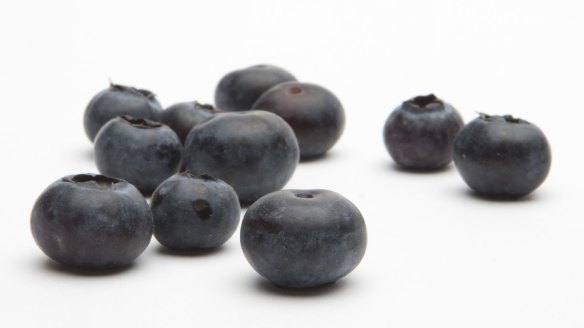
Mix-ins
While straight-up buttermilk pancakes are as good as gold, sometimes you want a little extra flavour. When introducing different ingredients into the batter, be modest: a little bit will go a long way. Too many mix-ins can make the pancake heavy or unbalanced. For larger items such as fruit and chocolate, start with 1½ cups and adjust based on your preference.
Berries
While blueberries have the pancake market cornered, raspberries and blackberries are also delicious. Slice large berries in half. To prevent berries from sinking to the bottom, toss them with a little bit of flour before folding into the batter. Adding berries to the batter can enhance a pancake made with flour swap: cornmeal and blueberries are a perfect match, or try blackberries and oat flour.
Bananas
Bananas are great as a topping, but try them inside the pancakes. Not only do they provide a luxuriously creamy interior, but their banana flavour is intensified as the pancakes cook (think: cheat's banana bread). Cut two bananas into slices about 1cm thick and stir them into the batter. For an especially gorgeous version, add a few slices to the top of the cooking pancake just as you're about to flip.
Chocolate
Mixing chocolate into your pancakes in the form of chips or chunks may push them towards more cake than pancake, but sometimes that's just the kind of thing you need to start the day. Choose a chocolate with some proper bitterness (look for anything 66 per cent and above) to prevent them from becoming overly sweet. You can also try chocolate shavings, which will give the batter a sweet unctuous flavour.
Zest and spice
Vanilla beans, lemon zest, ground cinnamon or freshly grated ginger are all welcome additions to pancakes. Add them into the batter before you start cooking. For these, just a pinch will do. Also consider cardamom, freshly grated nutmeg and allspice.

Toppings
Not everything belongs inside a pancake, and that's where the toppings come in. Melted butter and maple syrup are the classics, followed by a dollop of good jam. But try granola for a bit of crunch or smashed berries for a luxurious sweetness. Use restraint when topping your pancakes, and sometimes it's best to dip them in the topping, to preserve those crunchy edges.
Syrups
Good maple syrup is much easier to find these days. If it's labelled "pure" it's a pretty good indication of quality, but when in doubt, read the label to make sure nothing has been added. Other syrupy friends include warmed honey and agave syrup.
Butter and whipped cream
Yes, there is butter inside the pancake, but that's no reason not to slather some on top. For the just-melted perfect pat, make sure your butter is room temperature before dabbing it onto those hot-off-the-pan pancakes. And while whipped cream might not be your speed for a weekday morning, there is definitely a time and a place for it. Other great dairy alternatives include lightly sweetened mascarpone cheese, creme fraiche or even sour cream.
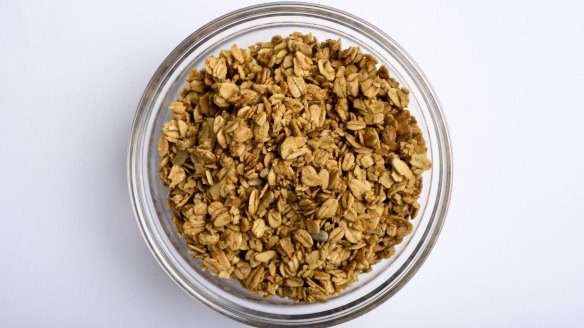
Crunchy bits
Chopped nuts, toasted coconut flakes, or a sprinkling of candied seeds are all welcome on top of a pancake, especially when paired with warm butter and syrup. Granola makes a delicious, unusual topping, and adds a bit of savoury crunch to a sweet breakfast. Don't be afraid of sea salt flakes for texture here, either.
Fruit
Fresh sliced fruit such as bananas, strawberries and peaches, and smashed berries make a great option for a lighter pancake topping. When tossed with the teeniest bit of sugar, they'll even create their own syrup. Or try warming them in a bit of maple syrup first. Choose what's in season, going for the ripest, juiciest things you can find.
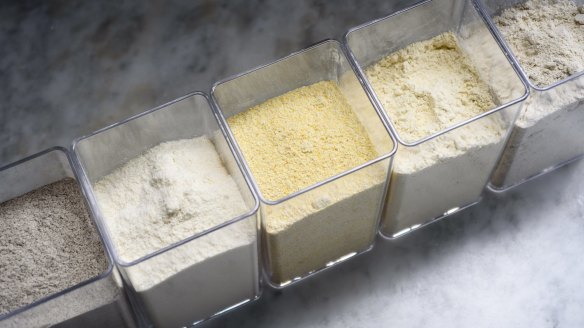
Alternative flours
Because of their manageable size and unfussy cooking method, pancakes are the perfect place to experiment with the flour itself. Swapping in different flours, such as buckwheat or coconut, with some of the plain flour will change the pancake's texture and taste in a delightful way. A good rule of thumb for most alternative flours is to substitute 25 per cent of the flour, which, if you go by our master recipe above, is ½ cup.
Buckwheat flour
Because the flavour of buckwheat is so assertive, a little bit goes a long way. Substitute ¼ cup flour here. These deeply earthy pancakes are decidedly a little bit more "adult" and especially delicious with warmed honey and flaky salt.
Coconut flour
Very mild in flavour, naturally sweet coconut flour will give you a softer, more delicate pancake without tasting like a bottle of sunscreen. These are clearly destined for banana pancake hall of fame.
Gluten-free flours
Of all the gluten-free flours on the market, Bob's Red Mill All-Purpose blend works best here. Its main ingredient is chickpea flour, the darling of the gluten-free world, which behaves more like plain flour. It does have a relatively assertive (but not unpleasant) flavour, and works far better for pancakes than a gluten-free option such as rice flour, which will give you a gummy texture. If going gluten-free, use 2½ cups of flour.
Oat flour
One of the trendier alternative flours out there, oat flour is just finely ground oats. Adding a bit to the batter is like stealthily giving your decadent breakfast a little protein boost without interfering with its flavour. It's surprisingly delicious with chocolate.
Wholemeal flour
For something a little more wholesome and deeper in flavour, splurge for a bag of the nice freshly milled stuff to let the nuttiness of the wheat shine through. Wholemeal pancakes are best eaten minimally adorned with some warm maple syrup and lots of extra butter.
©The New York Times
The best recipes from Australia's leading chefs straight to your inbox.
Sign upMore:
From our partners
Original URL: https://www.smh.com.au/goodfood/tips-and-advice/how-to-make-perfect-buttermilk-pancakes-20200219-h1lx15.html
